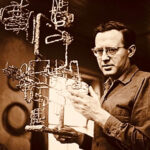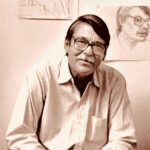Philip Guston
Philip Guston, born Philip Goldstein on June 27, 1913, in Montreal, Canada, was a trailblazing artist whose work spanned several styles and movements. Guston’s career is marked by his continuous evolution, from his early work influenced by Renaissance art and Mexican muralists to his association with Abstract Expressionism and later, his controversial shift to figurative painting. This article delves into Guston’s life, artistic journey, and highlights three of his most notable works.

Early Life and Artistic Beginnings
Guston moved to Los Angeles with his family in 1919. Growing up in California, he became friends with Jackson Pollock, another future Abstract Expressionist. Both attended the Manual Arts High School, where they were exposed to modernist ideas. Guston’s early artistic influences included the Renaissance masters, Mexican muralists like Diego Rivera, and the social realist paintings of the 1930s.
In 1931, Guston received a scholarship to the Otis Art Institute in Los Angeles but left after only a year, dissatisfied with the formal education. He began creating public murals, which reflected his interest in social issues and his admiration for the work of Rivera and José Clemente Orozco.
The Abstract Expressionist Phase
Guston moved to New York City in 1935, where he became involved with the Works Progress Administration (WPA) Federal Art Project, creating murals and working alongside artists like Willem de Kooning and Pollock. By the late 1940s, Guston had shifted towards Abstract Expressionism, a movement characterized by spontaneous, automatic, or subconscious creation.
Guston’s abstract works were known for their lyrical quality, often featuring loose, gestural brushstrokes and a palette of muted colors. His paintings from this period, such as “The Tormentors” (1947-48), exhibit a sense of mystery and emotion, with layered forms and a dream-like quality.
Notable Works
1. “The Studio” (1969)
“The Studio” is one of Guston’s most famous works from his late period when he made a dramatic return to figurative painting. The painting depicts a hooded figure (a recurring motif in his later work) painting a self-portrait. This piece is significant because it reflects Guston’s introspection and his commentary on the role of the artist.
The painting’s style, with its thick, cartoonish lines and grotesque figures, was a stark departure from his abstract works. This shift was controversial and initially met with criticism, but it has since been recognized as a profound exploration of personal and political themes.
2. “City Limits” (1969)
“City Limits” is another key work from Guston’s figurative period. This painting features a cluster of hooded figures, reminiscent of Ku Klux Klan members, set against an urban landscape. The stark, simplified forms and the use of pink and red hues create a chilling, oppressive atmosphere.
This painting, like many of Guston’s late works, serves as a powerful critique of contemporary society, addressing issues of racism, violence, and the artist’s own complicity in these systems. The direct, confrontational imagery was a bold move, distancing Guston from the abstraction that had defined much of his earlier career.
3. “Painting, Smoking, Eating” (1973)
“Painting, Smoking, Eating” is a quintessential example of Guston’s late style, depicting a hooded figure engaged in the mundane activities of painting, smoking, and eating. The painting’s simple, almost cartoonish style belies its deeper significance, reflecting Guston’s contemplation of the artist’s life and the human condition.
The use of everyday objects and the hooded figure – a symbol that is both self-referential and culturally charged – encapsulate Guston’s exploration of identity, isolation, and the artist’s role in society. This work, like many of Guston’s late paintings, blends the personal with the political, creating a rich, multi-layered narrative.
Techniques and Innovations
Guston’s technique evolved significantly throughout his career. His early murals demonstrated his mastery of large-scale compositions and social realism, while his abstract works showcased his ability to convey emotion and atmosphere through color and form. His use of loose, gestural brushstrokes and muted palettes in his abstract phase created a sense of depth and movement.
The dramatic shift to figurative painting in the late 1960s marked a significant innovation in Guston’s work. His use of thick, cartoonish lines and simplified forms created a stark, impactful style that conveyed complex themes with a direct, almost brutal honesty. This style, initially controversial, has since been recognized for its boldness and originality, influencing subsequent generations of artists.
Personal Life and Influence
Guston’s personal life was as complex and evolving as his art. He married poet and artist Musa McKim in 1937, and the couple had a daughter, Musa Mayer, who later became a writer and art critic. Throughout his life, Guston maintained close relationships with other prominent artists, including Willem de Kooning, Mark Rothko, and Barnett Newman.
Guston’s shift to figurative painting in the late 1960s was partly influenced by the political and social turmoil of the time, including the Vietnam War and the civil rights movement. His late works reflect his deep engagement with these issues, as well as his introspection and self-critique as an artist.
Recognition and Legacy
Philip Guston’s contributions to modern art are widely recognized and celebrated. His works are held in major museums and collections around the world, including the Museum of Modern Art in New York, the Tate Modern in London, and the Art Institute of Chicago. His influence extends beyond his own generation, impacting contemporary artists who continue to explore the boundaries between abstraction and figuration.
Guston’s legacy is marked by his fearless exploration of new styles and themes, his commitment to addressing social and political issues through his art, and his profound impact on the development of modern art. His work continues to inspire and challenge artists and viewers alike, reflecting his enduring relevance and significance in the art world.
Conclusion
Philip Guston was a pioneering artist whose work spanned several styles and movements, from early social realism to Abstract Expressionism and later, his controversial shift to figurative painting. Through his most notable works, such as “The Studio,” “City Limits,” and “Painting, Smoking, Eating,” Guston explored the complexities of identity, society, and the artist’s role in the world. His innovative techniques, bold thematic explorations, and profound influence on subsequent generations of artists ensure his lasting legacy in the history of modern art.



